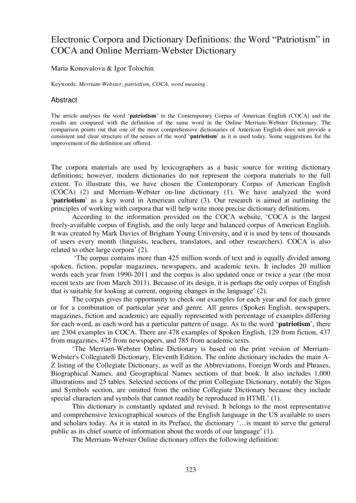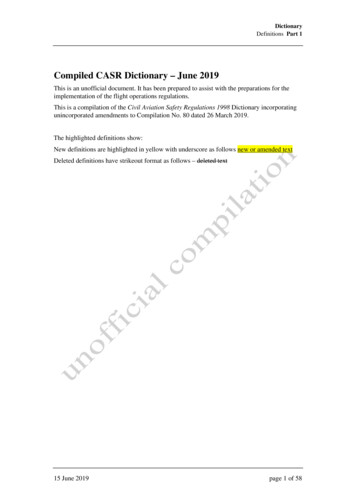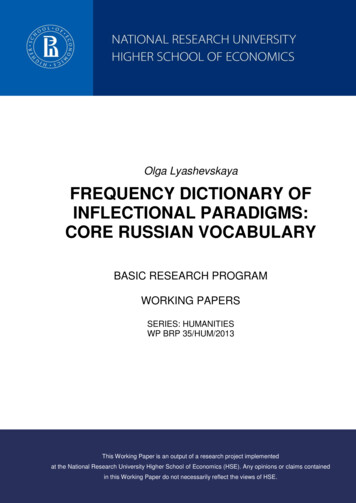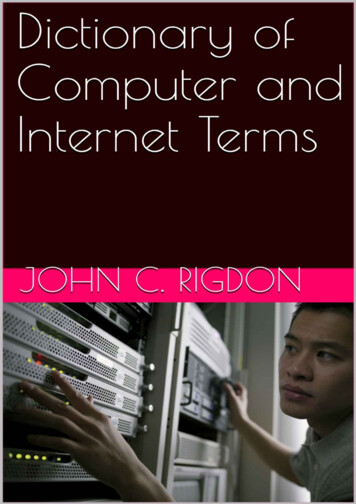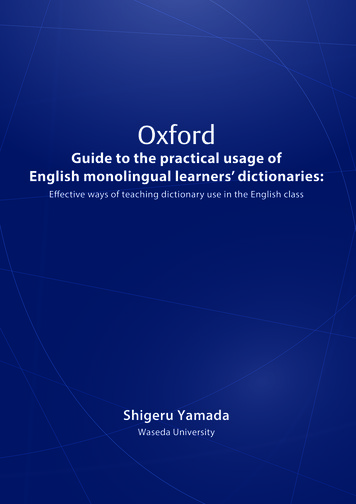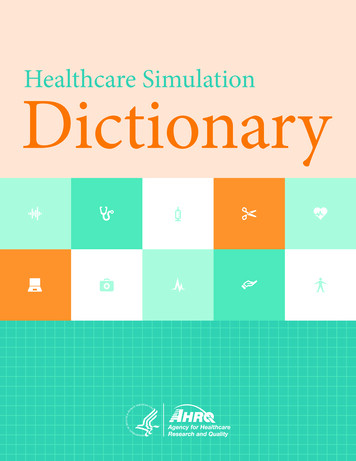
Transcription
Healthcare SimulationDictionarye
The Healthcare Simulation Dictionary is the intellectual property of The Society for Simulation in Healthcare (SSH). TheAgency for Healthcare Research and Quality (AHRQ) has a license to use and disseminate the work. Each user is granted aroyalty-free, non-exclusive, non-transferable license to use the dictionary in their work. The dictionary may not be changedin any way by any user. The contents of the dictionary may be used and incorporated into other work under the conditionthat no fee is charged by the developer to the user. The dictionary may not be sold for profit or incorporated into anyprofit-making venture without the expressed written permission of the SSH. Citation of the source is appreciated.Suggested Citation: Lopreiato J O. Healthcare Simulation Dictionary. Rockville, MD: Agency for Healthcare Research andQuality; October 2016. AHRQ Publication No. 16(17)-0043.
ContributorsEditorJoseph O. LopreiatoSociety for Simulation in HealthcareAssociate EditorsDayna DowningWendy GammonLori LioceBarbara SittnerVickie SlotAndrew SpainConsultant LexicographerOrin HargreavesTerminology & Concepts Working GroupAdalberto Amaya AfanadorGuillaume AlinierMeg AndersonWendy AnsonZalim BalkizovBryn BaxendaleFilippo BresnanSharon CalamanJuleen CampbellJeff CarmackReba Moyer ChildressHyun Soo ChungDon CoerverFrank CoffeyLinda CrelinstenRoger Daglius DiasJohn DeanSharon DeckerIgnacio del MoralCarol DurhamChad EppsDavid FeinsteinKirsty FreemanDavid GabaLaura GantGayle GlivaTeresa GoreYue Ming HuangKeiichi IkegamiDebbie JohnstonSuzan Kardong-EdgrenMichelle KellyKrista KipperSabrina KohHani LababidiElyssebeth LeighKaren LewisHelge LorentzenJose M MaestreBeth ManciniJenn ManosAlejandro MartinezFrancisco MatosColleen MeakimMaurizio MenariniDebra NestelCate NicholasJane PaigeJanice PalaganasMary PattersonDan RaemerGwenn RandallJan Joost RethansKaren ReynoldsJohn RiceJill SankoLesley ScottKris SlawinskiMary Kay SmithElsa SoylandMarzia SpessotJessica Stokes-ParishDemian SzyldDeb TauberWendy ThomsonJane TorrieTess VawserW I T H T H E S UP P ORT A ND INP U T OF: Association for Simulated Practice in Health care (ASPiH) Association forStandardized Patient Educators (ASPE) Australian Society for Simulation in Health care (ASSH) Brasilian Association forSimulation in Health (Abrassim) Canadian Network for Simulation in Health care (CNSH) Chilean Society of Clinical Simulation Dutch Society for Simulation in Health care (DSSH) International Nursing Association for Clinical Simulation in Learning (INACSL) International Pediatric Simulation Society (IPSS) Italian Society for Simulation in Healthcare Japan Society for InstructionalSystems in Health care (JSISH) Korean Society for Simulation in Health care (KoSSH) Latin American Association for ClinicalSimulation (ALASIC) New Zealand Association for Simulation in Health care (NZASH) Pan Asia Society for Simulation inHealth care (PASSH) Polish Society of Medical Simulation (PSMS) Portuguese Society for Simulation (SPSim) Russian Societyfor Simulation Education in Medicine (ROSOMED) Society in Europe for Simulation Applied to Medicine (SESAM) SpanishSociety of Clinical Simulation and Patient Safety (SESSEP)1
PrefaceIn January 2013, an international group of simulation experts gathered in Orlando,Florida, U.S.A. to form a working team whose mission was to create a dictionary of termsused in health care simulation. This group recognized a need to compile terms that hadbeen completed by other groups in health care simulation and to add more terms. Thedocument you see represents the work of many individuals and their societies to compileand refine the dictionary. The goal of this project is to enhance communication and clarityfor health care simulationists in teaching, education, assessment, research, and systemsintegration activities. The Agency for Health care Research and Quality (AHRQ) haspartnered with the Society for Simulation in Healthcare and its many affiliates to producethe first comprehensive Healthcare Simulation Dictionary and disseminate it widely aspart of AHRQ’s mission to improve patient safety, which includes simulation research.There are some key points to keep in mind when looking at this document, because it is notperfect, nor complete. This is a living document and represents the sum of the workat this moment. Terms and definitions will change and beedited, added, or deleted over time. The intent was to be inclusive of the various definitions inuse, not to exclude any definitions or areas of health caresimulation. This collection of definitions shows how the terms are beingused in health care simulation. It is not intended to dictateone particular definition over another. This dictionary focuses on health-care-simulation-specificterms and meanings. Many terms that are generally usedin education (e.g., educational design) and health care (e.g.,ventricular fibrillation or anxiety) are not defined. The readeris referred to standard dictionaries and resources for thesedefinitions. This list of terms is not a taxonomy, nor should it be used assuch. It may inform taxonomical work. Terms that have been identified as potentially controversialhave been noted with a * prior to the word. The terms and spellings are written in standard AmericanEnglish. This was at the recommendation of our consultantlexicographer to aid in reducing clutter and supporttranslation to other languages. As a living document, all are encouraged to submit feedbackusing the form located at www.ssih.org/dictionary. We realizethere may be better insights into other terms or definitions,additional references, etc. Citations have been included wherever possible. Should youknow of additional and/or missing citations, please submitthose as above. Original citations are preferred.The Society for Simulation in Healthcare (SSH) acknowledges the participation and input of many individuals and also theSocieties they represent. Without you, this would not have been possible! Thank you for your time and efforts in the creation of thisdictionary over the last 3 years.Joseph O. Lopreiato M.D., M.P.H.October 20163
A*Actor \ˈak-tər \ nounAugmented Reality \ȯg-ˈmen-təd \ rē-ˈa-lə-tē \ nounEtym. late 14c., “an overseer, guardian, steward,” from Latin actor“an agent or doer,” also “theatrical player,” from past participle stemof agere. Sense of “one who performs in plays” is 1580s, originallyapplied to both men and women.Etym. augment (v.) c. 1400, from Old French augmenter “increase,enhance” (14c.), from Late Latin augmentare “to increase,” fromLatin augmentum “an increase,” from augere “to increase, make big,enlarge, enrich.” Related: Augmented; augmenting.DefinitionEtym. reality (n.) 1540s, “quality of being real,” from Frenchréalité and directly Medieval Latin realitatem (nominative realitas);Meaning “real existence, all that is real.” In health care simulation, professional and/or amateur peopletrained to reproduce the components of real clinical experience,especially involving communication between health professionalsand patients or colleagues (Australian Society for Simulation inHealthcare).See also: CONFEDERATE, EMBEDDED PARTICIPANT, ROLE PLAYER,SIMULATED PATIENT, SIMULATED PERSON, STANDARDIZED PATIENTAdvocacy and Inquiry \ad-və-kə-sē \ in-ˈkwī(-ə)r-e\ nounEtym. advocate (n.) mid-14c., “one whose profession is to pleadcases in a court of justice,” a technical term from Roman law. Also inMiddle English as “one who intercedes for another,” and “protector,champion, patron.”Etym. inquest (n.) mid-15c., enquery, from enquere (see ‘inquire’).From Latin methodus “way of teaching or going,” from Greekmethodos “scientific inquiry,” method of inquiry, investigation.Definition A method of debriefing in which an observer states what wasobserved or performed in a simulation activity (advocacy)or shares critical or appreciative insights about it explicitly(advocacy) and then asks the learners for an explanation of theirthoughts or actions (inquiry)(Rudolph et al, 2007). Inquiry seeks to learn what others think, know, want, or feel;whereas advocacy includes statements that communicate what anindividual thinks, knows, wants or feels (Bolman & Deal, 2013).Definition A type of virtual reality in which synthetic stimuli aresuperimposed on real-world objects, usually to make informationthat is otherwise imperceptible to human senses perceptible(M&S Glossary). A technology that overlays digital computer-generatedinformation on objects or places in the real world for the purposeof enhancing the user experience. The combination of reality and overlay of digital informationdesigned to enhance the learning process. A spectrum of mixed-reality simulation that is part way betweenthe real world and the virtual world. A form of virtual reality that includes head-mounted displays,overlays of computer screens, wearable computers, or displaysprojected onto humans and manikins (D.R. Berryman et al; M.Bajura et al; H. Fuchs et al).Avatar \ˈa-və-ˌtär\ nounEtym. 1784, “descent of a Hindu deity,” from Sanskrit. In computeruse, it seems to trace to the novel “Snowcrash” (1992) by NealStephenson.DefinitionAssessor \ ə-ˈse-sər \ nounEtym. late 14c., from Old French assessor “assistant judge, assessor(in court)” (12c., Modern French assesseur) and directly from Latinassessor “an assistant, aid; an assistant judge.”Definition A graphical representation, typically three-dimensional, of aperson capable of relatively complex actions, including facialexpression and physical responses, while participating in avirtual simulation-based experience. The user controls the avatarthrough the use of a mouse, keyboard, or a type of joystick tomove through the virtual simulation-based experience. (Riley,2015). A person who performs assessment of individuals according topre-established criteria. Assessors must have specific and substantial training, expertise,and competency in assessment (Dictionary.com).*Term that has been identified as potentially controversial.5
BBrief (Briefing) \ brēf\ noun (\ˈbrē-fiŋ\ verb )Note: this term is often not clearly distinguished from Orientationor PrebriefingEtym. “fact or situation of giving preliminary instructions.” 1910Definition An activity immediately preceding the start of a simulationactivity where the participants receive essential information aboutthe simulation scenario, such as background information, vitalsigns, instructions, or guidelines. For example, before beginninga session, faculty conduct a briefing about the scenario to reviewthe information being provided to the participants. The information and guidelines given to faculty or simulatedpatients participating in a scenario to allow them to fully preparefor interactions with the participants. Briefing materials couldinclude a handover, physician referral letter, or an ambulance calltranscript. For example, at the start of the simulation scenario,participants receive a notification from ambulance personnelregarding a patient being transported to their facility with agunshot wound. (Alinier, 2011; Husebø et al., 2012).See also: ORIENTATION, PREBRIEFING6
CClinical Scenario \ kli-ni-kəl \ sə-ˈner-ē-ˌō \ nounEtym. scenario (n.) 1868, “sketch of the plot of a play,” from Italianscenario, from Late Latin scenarius “of stage scenes,” from Latinscena “scene.”Etym. clinical (adj.) 1780, “pertaining to hospital patients or hospitalcare,” from clinic -al.Definition The plan of an expected and potential course of events for asimulated clinical experience. A scenario usually includes thecontext for the simulation (hospital ward, emergency room,operating room, clinic, out of hospital, etc.). Scenarios can vary inlength and complexity, depending on the learning objectives. A detailed outline of a clinical encounter that includes: theparticipants in the event, briefing notes, goals and learningobjectives, participant instructions, patient information,environmental conditions, manikin or standardized patientpreparation, related equipment, props, and tools or resources forassessing and managing the simulated experience. A progressive outline of a clinical encounter, including abeginning, an ending, a debriefing, and evaluation criteria(Meakim et al., 2013).See also: SCENARIO, SCRIPT, SIMULATED-BASED LEARNINGEXPERIENCE, SIMULATION ACTIVITYComputer-Based Simulation \ kəm-ˈpyü-tər \ bāst\ sim-yuh-ley-shuh n \ nounE tym. computer (n.) 1640s, “one who calculates,” agent noun fromcompute (v.). Meaning “calculating machine” (of any type) is from1897; in modern use, “programmable digital electronic computer”(1945 under this name; theoretical from 1937, as Turing machine).ENIAC (1946) usually is considered the first.E tym. simulation (n.) noun of action from past participle stem ofsimulare “imitate,” from stem of similis “like.” Meaning “a model ormock-up for purposes of experiment or training” is from 1954.D efinition A simulation-based learning activity designed to provide anexperience with inputs and outputs exclusively confined to acomputer, usually associated with a monitor and a keyboard orother assistive device. (Textbook of Simulation, 2012). Learnerscan complete specific tasks in a variety of potential environments,use information to provide assessment and care, make clinicaldecisions, and observe the results in action. Feedback can beprovided during and after the interaction ( Durham & Alden,2008). Facets of computer-based simulation include virtual patients,virtual reality task trainers, and immersive virtual realitysimulation (Textbook of Simulation, 2012).S ee also: SCREEN-BASED SIMULATION, SIMULATOR, VIRTUALR EALITYCoaching \ kōch-iŋ \ verbEtym. Meaning “to prepare (someone) for an exam.”Related: Coached; coaching.Definition A method of directing or instructing a person or group of peoplein order to achieve a goal or goals, develop a specific skill orskills, or develop a competency or competencies. (InternationalNursing Association for Simulation and Clinical Learning, 2011)Conceptual Fidelity \ kən-ˈsep-chə-wəl \ fə-ˈde-lə-tē, fī- \ nounEtym. conceptual (adj.) 1820, “pertaining to mental conception”(there is an isolated use from 1662), from Medieval Latinconceptualis, from Latin conceptus” a collecting, gathering,conceiving,” past participle of concipere. Related: Conceptualism;conceptualist.Etym. fidelity (n.) early 15c., “faithfulness, devotion,” from MiddleFrench fidélité (15c.), from Latin fidelitatem (nominative fidelitas)“faithfulness, adherence.”Definition In health care simulation, ensures that all elements of the scenariorelate to each other in a realistic way so that the case makessense as a whole to the learner(s) (For example: Vital signs areconsistent with the diagnosis). To maximize conceptual fidelity,cases or scenarios should be reviewed by subject matter expert(s)and pilot-tested prior to use with learners (Rudolph et al., 2007;Dieckmann et al., 2007).7
*Confederate \ kən-ˈfe-d(ə-)rət \ nounEtym. late 14c., from Late Latin confoederatus “leagued together,”past participle of confoederare “to unite by a league,” from com“with, together.”Definition An individual(s) who, during the course of the clinical scenario,provides assistance locating and/or troubleshooting equipment.This individual(s) may provide support for participants in theform of ‘help available’, e.g. ‘nurse in charge’, and/or to provideinformation about the manikin that is not available in other ways,e.g., temperature, color change, and/or to provide additionalrealism by playing the role of a relative or a staff member(Australian Society for Simulation in Healthcare). An individual other than the patient, who is scripted in asimulation to provide realism, additional challenges, or additionalinformation for the learner, e.g., paramedic, receptionist, familymember, laboratory technician (Victorian Simulated PatientNetwork).See also: ACTOR, EMBEDDED PARTICIPANT, SIMULATED PATIENT,SIMULATED PERSON, STANDARDIZED PATIENTCueing \ˈkyü – iŋ \ verbEtym. cue (n.) “stage direction,” 1550s, from Q, which was used16c., 17c. in stage plays to indicate actors’ entrances, probably as anabbreviation of Latin quando “when” or a similar Latin adverb.Definition To provide information during the simulation that helps theparticipant progress through the activity to achieve statedobjectives (modified from National League for Nursing Simulation Innovation Resource Center, 2013). noun Information provided to help the learner reach the learningobjectives (conceptual cues), or to help the learner interpret orclarify the simulated reality (reality cues). Conceptual cues helpthe learner reach instructional objectives through programmableequipment, the environment, or through responses from thesimulated patient or role player, Reality cues to help the learnerinterpret or clarify simulated reality through informationdelivered during the simulation (modified from Paige & Morin,2013).*Term that has been identified as potentially controversial.8
DDebrief (Debriefing) \ dēˈbrēf \ noun (\ dē ˈbrē-fiŋ\ verb)Deliberate Practice \di-ˈli-bə-rāt\ˈprak-təs\ nounEtym. debrief “obtain information (from someone) at the end of amission,” 1945, from de- brief (v.). Related: Debriefed; debriefing.Etym. deliberate (adj.) 15th century Middle English, from LatinDefinition (noun) A formal, collaborative, reflective process within thesimulation learning activity. An activity that follows a simulation experience and led by afacilitator. (verb) To conduct a session after a simulation event whereeducators/instructors/facilitators and learners re-examinethe simulation experience for the purpose of moving towardassimilation and accommodation of learning to future situations(Johnson-Russell & Bailey, 2010; National League for Nursing Simulation Innovation Resource Center, 2013); debriefing shouldfoster the development of clinical judgment and critical thinkingskills (Johnson-Russell & Bailey, 2010).deliberatus, past participle of deliberare to consider carefully,perhaps alteration of *delibrare, from de- libra scale, pound.Etym. practice (n.) 14th century Middle English practisen, fromMiddle French practiser, from Medieval Latin practizare, alterationof practicare, from practica practice, noun, from Late Latin practice,from Greek praktikē, from feminine of praktikos.Definition A theory of general psychology that states the differencesbetween expert performers and normal adults reflect a life-longperiod of deliberate effort to improve performance in a specificdomain. (Ericsson, K. A). A systematically designed activity that has been createdspecifically to improve an individual’s performance in a givendomain (Ericsson, Krampe, & Tesch-Römer, 1993). To encourage participants’ reflective thinking and providefeedback about their performance, while various aspects of thecompleted simulation are discussed.Compare: MASTERY LEARNING To explore with participants their emotions and to question,reflect, and provide feedback to one another (i.e., guidedreflection).Deterministic \ di-ˈtər-mə-ˌni- stik \ adjCompare: ADVOCACY AND INQUIRY, FEEDBACK, GUIDEDREFLECTIONEtym. determinism (n.) 1876 in general sense of “doctrine thateverything happens by a necessary causation,” from Frenchdéterminisme; deterministic (adj.) 1874, from determinist (seedeterminism) -ic.DefinitionDebriefer \ dē-ˈbrēf - ur\ nounEtym. debrief “obtain information (from someone) at the end of amission,” 1945, from de- brief (v.). Related: Debriefed; debriefing. Pertaining to a process, model, or variable whose outcome, result,or value does not depend on chance (Department of DefenseModeling and Simulation Glossary).Contrast with: STOCHASTICDefinition The individual who facilitates a debriefing session and isknowledgeable and skilled in performing appropriate, structured,and psychologically safe debriefing sessions (Fanning & Gaba,2007). The person who leads participants through the debriefing.Debriefing by competent instructors and subject matter experts isconsidered important to maximize the opportunities arising fromsimulation (Raemer et al, 2011).Compare: FACILITATOR, SIMULATIONIST9
Discrete Simulation (Discrete-Event Simulation)\ dis-ˈkrēt \ sim-yuh-ley-shuh n \ nounEtym. discrete (adj.) mid-14c., “morally discerning, prudent,circumspect,” from Old French discret “discreet, sensible, intelligent,wise,” from Latin discretus “separated, distinct;” in Medieval Latin,“discerning, careful;” past participle of discernere “distinguish.”Meaning “separate, distinct” in English is late 14c.Etym. simulation (n.) noun of action from past participle stem ofsimulare “imitate,” from stem of similis “like.” Meaning “a model ormock-up for purposes of experiment or training” is from 1954.Definition A simulation that relies on variables changed only at a countablenumber of points in time; discrete event simulation (DES) is theprocess of codifying the behavior of a complex system as anordered sequence of well-defined events. The operation of a system as a discrete sequence of events intime. Each event occurs at a particular instant in time and marksa change of state in the system. Between consecutive events, nochange in the system is assumed to occur; thus the simulationcan directly jump in time from one event to the next (Robinson,2004). One or more variables that completely describe a system at anygiven moment in time (Sokolowski & Banks, 2011).Distributed Simulation\ di-ˈstri-byüt \ sim-yuh-ley-shuh n \ nounEtym. distribute (v.) early 15c., “to deal out or apportion,” fromLatin distributus, past participle of distribuere “to divide, distribute.”Related: Distributable; distributed; distributing.Etym. simulation (n.) noun of action from past participle stem ofsimulare “imitate,” from stem of similis “like.” Meaning “a model ormock-up for purposes of experiment or training” is from 1954.Definition The concept of simulation on-demand, made widely availablewherever and whenever it is required; DS provides an easilytransportable, self-contained ‘set’ for creating simulatedenvironments, at a fraction of the cost of dedicated, staticsimulation facilities (Kneebone et al, 2010). A set of simulations operating in a common environmentand distributed to learners; a distributed simulation may becomposed of any of the three modes of simulation: live, virtual,and constructive, and are seamlessly integrated within a singleexercise (Department of Defense Modeling and SimulationGlossary).10Domains of Learning‘‘Three separate, yet interdependent components of learningoutcomes achievable by human learners. These domains: cognitive,affective, and psychomotor, represent various categories and levelsof learning complexity and are commonly referred to as educationaltaxonomies.’’ (Bloom, 1956).Table 1: Comparison of Bloom’s original taxonomy (1956) andBloom’s revised taxonomies with Quality and Safety Educationfor Nurses (QSEN) competencies and knowledge, skills, andattitudes (From Longman et al, 2001; Menix, 1996; andCronenwett et al, 2007).Domains of LearningKnowledge DimensionQSEN CompetenciesOriginal Bloom’sTaxonomyRevised Bloom’s TaxonomyQSEN ProjectCognitiveFactual knowledgeConceptual knowledgeKnowledgePsychomotorProcedural knowledgeSkillsAffectiveMetacognitive knowledgeAttitudes
EEmbedded Participant \ im-ˈbed \ id \ pär-ˈti-sə-pənt \ nounEvaluation \ əˈvalyəˌwāt/shun \ nounEtym. embed (v.) 1778, “to lay in a bed (of surrounding matter),”from em- (1) bed (n.). Originally a geological term, in referenceto fossils in rock; figurative sense is by 1835; meaning “place (ajournalist) within a military unit at war” is from 2003 and the Iraqwar. Related: Embedded; embedding.Etym. Evaluation (noun) mid 19th century: back-formation fromevaluation, from French évaluer, from es- (from Latin ex- ) ‘out,from’ Old French value ‘value.’Etym. participant (n.) 1560s, from Middle French participant, fromLatin participantem, present participle of participare “to share in,partake of” from particeps “sharing, partaking.”A broad term for appraising data or placing a value on data gatheredthrough one or more measurements. It involves rendering a judgment,including strengths and weaknesses. Evaluation measures quality andproductivity against a standard of performance. (Bourke & Ihrke,2016). Introduction to the evaluation process.DefinitionDefinition An individual who is trained or scripted to play a role in asimulation encounter in order to guide the scenario, and may beknown or unknown to the participants; guidance may be positiveor negative, or a distractor based on the objectives, level of theparticipants, and the needs of the scenario. A role assigned in a simulation encounter to help guide thescenario. The guidance may be positive, negative, or neutralor as a distracter, depending on the objective(s), the level ofthe participants, and the scenario. Although the embeddedparticipant’s role is part of the situation, the underlying purposeof the role may not be revealed to the participants in the scenarioor simulation. (Meakim et al., 2013).See also: ACTOR, CONFEDERATE, ROLE PLAYER, SIMULATEDPATIENT, SIMULATED PERSON, STANDARDIZED PATIENTEnvironmental Fidelity\ en - vī-rə(n)-ˈmen-tə- l \ fə-ˈde-lə-tē \ nounEtym. environmental (adj.) 1887, “environing, surrounding,” fromenvironment -al (1). Ecological sense by 1967.Related: Environmentally.Etym. fidelity (n.) early 15c., “faithfulness, devotion,” from MiddleFrench fidélité (15c.), from Latin fidelitatem (nominative fidelitas)“faithfulness, adherence, trustiness,” from fidelis “faithful, true,trusty, sincere,” from fides “faith.” From 1530s as “faithful adherenceto truth or reality;” specifically of sound reproduction from 1878.Definition The degree to which the simulated environment (manikin, room,tools, equipment, moulage, and sensory props) replicates realityand appearance of the real environment.See also: FIDELITY, HIGH FIDELITY SIMULATION, PHYSICAL FIDELITY,REALISMFormative Evaluation Evaluation wherein the facilitator’s focus is on the participant’sprogress toward goal attainment through preset criteria; a processfor an individual or group engaged in a simulation activity for thepurpose of providing constructive feedback for that individualor group to improve. (National League for Nursing SimulationInnovation Resource Center, 2013).Summative Evaluation Evaluation at the end of a learning period or at a discrete pointin time in which participants are provided with feedback abouttheir achievement of outcome through preset criteria; a processfor determining the competence of a participant engaged in healthcare activity. The assessment of achievement of outcome criteriamay be associated with an assigned grade. (ibid)Event \ i-ˈvent \ nounEtym. 1570s, “the consequence of anything” (as in in the event that);1580s, “that which happens;” from Middle French event, from Latineventus “occurrence, accident, event, fortune, fate, lot, issue,” frompast participle stem of evenire “to come out, happen, result,” fromassimilated form of ex- “out” venire “to come.” Meaning “a contestor single proceeding in a public sport” is from 1865. Events as “thecourse of events” is attested from 1842.Definition The occurrences that cause variation or changes in the state of asystem (Sokolowski and Banks, 2009); in health care simulation,this term is common when programming manikins and oftenrefers to learner actions. An event is described by the time it occurs and event lists can becreated to drive changes in a simulation.See also: STATE/STATES11
FFacilitator (Simulation Facilitator) \fə-ˈsi-lə-ˌtā-tər\ nounFiction Contract \ˈfik-shən\ ˈkän-ˌtrakt\ nounEtym. 1806, agent noun in Latin form from facilitate.Etym. fiction (n.) something that is not true; something invented byDefinition An individual who is involved in the implementation and/ordelivery of simulation activities. For example, faculty, educators,etc. An individual that helps to bring about an outcome (such aslearning, productivity, or communication) by providing indirector unobtrusive assistance, guidance, or supervision. For example:The debriefing facilitator kept the discussion flowing smoothly.Compare: DEBRIEFER, SIMULATIONISTFeedback \ fēd-ˌbak \ nounEtym. 1920, in the electronics sense, “the return of a fraction of anoutput signal to the input of an earlier stage,” from verbal phrase,from feed (v.) back (adv.). Transferred use, “information about theresults of a process” is attested by 1955.Definition An activity where information is relayed back to a learner;feedback should be constructive, address specific aspects of thelearner’s performance, and be focused on the learning objectives(Society for Simulation in Healthcare). Information transferred between participants, facilitator,simulator, or peer with the intention of improving theunderstanding of concepts or aspects of performance (Meakimet al., 2013). Feedback can be delivered by an instructor, amachine, a computer, a patient (or a simulated person), or byother learners as long as it is part of the learning process.Compare: ADVOCACY AND INQUIRY, DEBRIEF/DEBRIEFING,GUIDED REFLECTIONthe imagination or feigned; an assumption of a possibility as a factirrespective of the question of its truth; a useful illusion or pretense;the action of feigning or of creating with the imagination.Etym. contract (n.) a binding agreement between two or morepersons or parties.Definition A concept that implies that an engagement in simulation is acontract between the instructor and the learner: each has to dohis or her part to make the simulation worthwhile (Rudolph,Dieckmann, et al.). The degree of engagement that health care trainees are willingto give the simulated event. Also known as the “suspension ofdisbelief,” it is a literary and theatrical concept that encouragesparticipants to put aside their disbelief and accept the simulatedexercise as being r
The dictionary may not be changed in any way by any user. The contents of the dictionary may be used and incorporated into other work under the condition that no fee is charged by the developer to the user. The dictionary may not be sold for profit or incorporated into any profit-making venture without the expressed written permission of the SSH.


